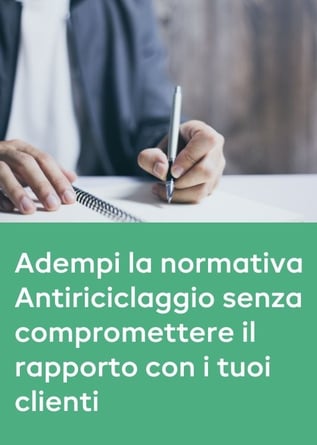- Prodotti
- RegLab per...
- Al centro di conoscenza
100% a prova di Antiriciclaggio
- Su RegLab
Chi siamo >
Lavoriamo con la convinzione che un onboarding efficace e corretto sia l'inizio di una relazione ottimale e a lungo termine con il cliente.
- Prenota una demo
Explaining the AML directive
AML (Anti Money Laundering) is the term for the international legislation on which the Dutch Money Laundering and Terrorist Financing Prevention Act (Wwft) is based. At European level, this regulation is known as the 5th AML directive. This article explains what this legislation entails and how it relates to AML.
AML directive: the meaning of it
AML stands for Anti Money Laundering. Previously, implementing an anti-money laundering policy was self-directed. After introducing European and national legislation, organisations were obliged to check their clients for money laundering. At European level, this regulation is called the Fifth Anti Money Laundering Directive (5AMLD). The guidelines for money laundering are laid down at European level. Based on these guidelines, EU countries must implement them in their own legislation.
In the Netherlands, these principles are laid down in the Money Laundering and Terrorist Financing Prevention Act (AML). If your organisation is subject to the AML, you must perform a Customer Due Diligence (CDD) check with your clients. The KYC policy is pivotal in this regard.
The AML directive facts in a nutshell:
- More and more organisations are putting AML high on the list of priorities to prevent reputational damage.
- Not only the financial sector, but also other sectors as well such as real estate and the legal sector are taking AML seriously.
- Organisations mainly focus on the front end of their processes. Think of customer acceptance and customer onboarding processes. Yet we see more and more organisations shifting their attention to continuous monitoring of customers.
Is 4th AML directive the predecessor of the 5th AML directive?
If you search for AML on the internet, you will read a lot about the 4th or Fourth AML directive. Yet this legislation has an update called The AMLD5, the Fifth Anti-Money Laundering directive. In 2020, the AML came into effect in the Netherlands. The main reason for the fifth update is the emergence of technology for the financial sector (Fintech) that uses digital currencies (crypto). This is a very interesting currency for criminals.
What is the difference between an AML audit and an UBO audit?
UBO is the abbreviation for Ultimate Beneficial Owner. An AML audit is a compliance audit of this person, the UBO. In this you investigate, on a financial level, whether the Ultimate Beneficial Owner of your business relationship is involved in money laundering.
RegLab for AML directive
Do you also spend a lot of time on a Know Your Customer and Customer Due Diligence policy to comply with AML requirements? Despite the frustrations they trigger, the KYC principles are becoming increasingly important. RegLab helps organisations to rapidly, safely and easily comply with Know your Customer policy laws and regulations.
Themed file: fully prepared for the supervisor’s audit
This article is part of a number of articles and downloads that will help you prepare yourself for the supervisor’s visit. This content is based on a supervisor's FAQs during an audit. Do you want to be 100% AML-proof and ready for the supervisor’s visit? Find all FAQs in our Knowledge Centre.

